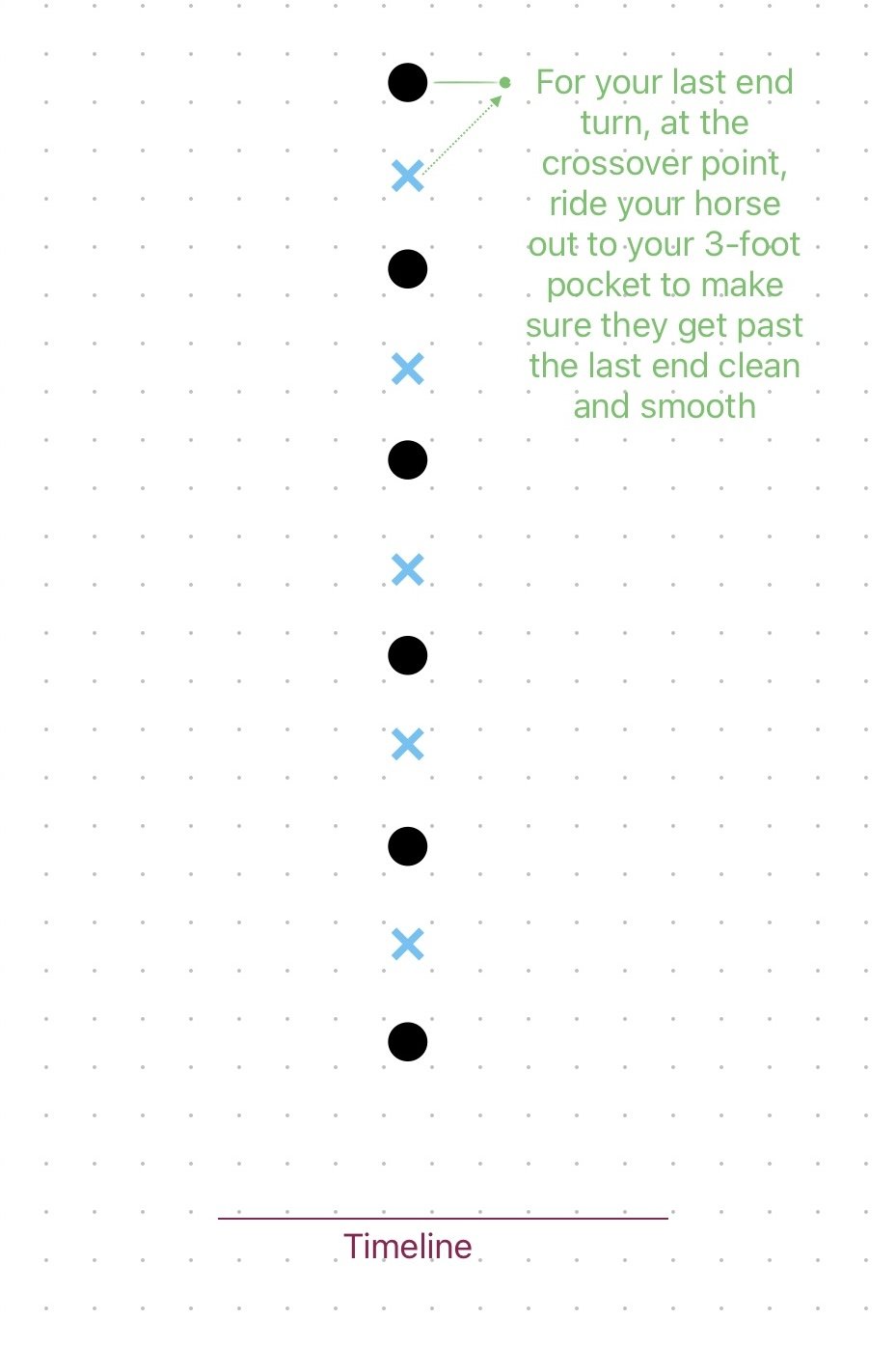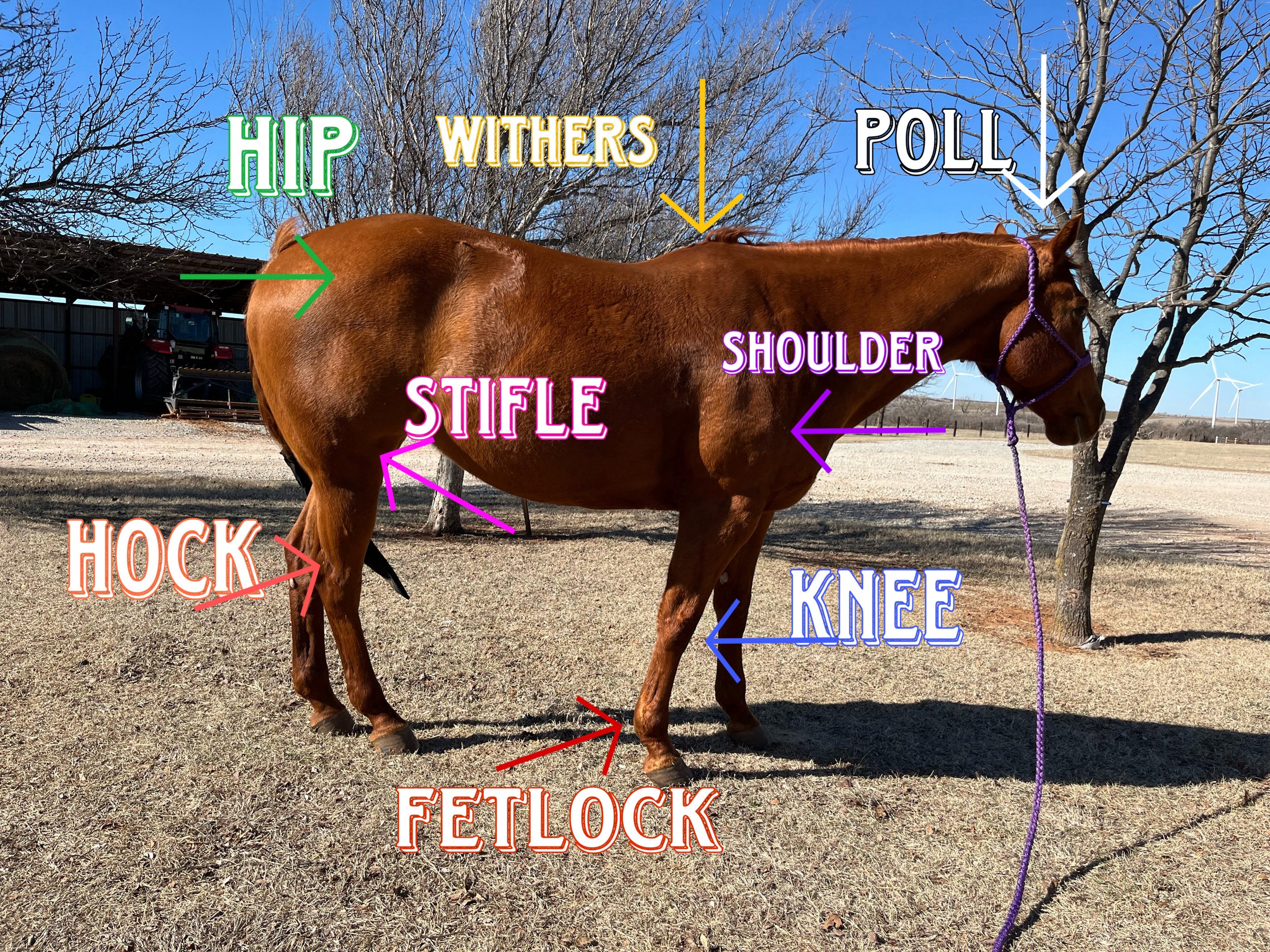Cowkids Only - May 2024
May 2024
Brought to you by The Bell Mare Book Company
Ask a Pro:
William Ball
This month’s blog features professional pole horse trainer William Ball. Horse training is a family business for William - his mother was a horse trainer and his brother also trains. William has found his specialty making pole bending horses that can win at the youth and high school rodeo level and beyond.
William gave us some great advice for youth pole benders on adding speed without adding penalties. Check it out!
Ask a Pro:
Professional Pole Bending Horse Trainer William Ball
Question: What is a common mistake you see among youth pole benders?
William’s Answer:
Too many riders, especially kids, use too much rein and don’t think about moving forward enough. Lots of kids will try and lift their inside hand to keep their horses off the poles during their weave. That’s not completely wrong, but it’s also not the fastest way. I am not saying I don’t use my reins at all, but I prefer to push my horse past my poles with my body position and feet before I let him cross over, versus lifting my inside rein and pulling him off the poles. When I do use my reins, I am never pulling back or up. I am just telling that horse to hold their distance, while continuing to push them forward with my feet, legs and body position. When you use your reins, you are killing forward momentum. When you push past the pole, rather than reining off them, you can get through the pattern faster. Horses naturally want to weave, so I don’t think we need to worry about telling them to weave. Just because there is a pole there, don’t move them off of it. We need to push them past our poles so they don’t start crossing over too early and so they keep going fast.
I think people who use their reins to lift horses off the poles a lot are riding scared. They are more afraid of knocking down a pole than they are wanting to be fast. Poles fall over super easy. You are going to knock them at some point when you go fast. But, you can’t be thinking about that when you are going through the pattern. I think a realistic goal in the poles is to be clean 80 percent of the time. If you can be clean 80 percent of the time and let go of the 20 percent of runs where you knocked a pole over, you are going to do great in this event.
Question: What do you think is the most overlooked part of the pole pattern?
William’s Answer:
Without a doubt, we focus too much on the weave and we don’t spend enough time focusing on making good end turns. The end turns make or break the pattern in my opinion. We either get too wide and mess up our timing at the first weave pole, or we get too close and the horse has a slight pause that costs precious time.
Let’s start with our first end pole. I see a lot of people run too close to the poles going down to the first end. I like my end poles to be turned like a barrel. Give that horse a pocket and let them make a nice round turn. Even if you are 8 feet out from the pole in your pocket, if that is what it takes for your horse to make a good turn without hesitation and a tight finish, that is going to be so much faster than cutting their pocket short and not having a smooth end turn. Find the pocket size that sets your horse up for a smooth first end turn and then stick with that approach every time. Don’t let what someone else is doing change your game plan.
On my end poles, especially the first end, I will ride two-handed down to the pole and then go one-handed and hold my horn going around it to really help my horse have a good, smooth turn. The turns are just as important, if not more important, in poles as they are in barrels. If you have perfect end poles, you basically have a free pass on the next pole because by finishing your end turn well, your horse is automatically set up for the next weave pole. So, if you have good ends, you really only have the two middle weave poles to worry about. Good end turns are really going to help you reach your 80 percent clean goal.
Now let’s go to the second end pole. This is a hard one, even for me. We have to encourage that forward movement through the weave and then at the second end we have to shut that down for just a split second and then pick it up again. That’s a hard maneuver for us and our horses. The best way I have found to make this easier is to train your horse to give themselves a pocket. As soon as they weave past that last pole before the end, they need to go to their pocket and treat the end pole like a turn, not a weave pole. The second end pole is going to have a smaller pocket than the first end because there just isn’t enough time or room for a big pocket. But, I like to shoot for a 3-foot pocket. Once you pass the last weave pole, train your eyes to look right at your pocket. That’s the best way to get your horse to give themselves a pocket without killing their momentum is to ride them with your eyes. If you cut the pocket off, you are going to either hit the end pole, blow off the backside of the end pole, or have a hesitation in your turn. If I am on a horse that really knows their job, I will ride around the end pole one-handed again to make sure they really finish that turn.
Don’t overlook the last end pole. I have seen the last end pole cost kids more money than any other pole. It’s the easiest turn and one that gets hit a lot. You have a great run and have been clean and you quit riding and the pole goes down. It’s the same as the second end. I want to look to my 3-foot pocket and give my horse the space he needs to make that last turn smoothly and without hesitation.
Below is a video of one of William’s 19-second pole bending runs in slow motion. This video will help you see the points he made above.
In the video below, we used freeze frames to help you see how William rides his horses through the weave and around the end turns.
Question: What do you recommend kids do between events to keep their horse tuned up on the pole pattern?
William’s Answer:
I trot through the pattern a lot with my finished horses. I make sure my horse is not anticipating the weave and crossing over too soon. I make sure I am crossing over in the middle of the poles, or maybe even a step past the middle if they are really anticipating that weave. I make sure they go to their pocket or maybe even a step or two wider than my pocket to help balance the anticipation that comes with speed.
Question: What do you look for in a pole horse?
William’s Answer:
There are some horses that are just too big to be pole horses. There’s only 21 feet between each pole and if that horse is really big and long, that cuts the amount of time they have to make those maneuvers. Not saying they can’t do it, but I think a smaller horse with a long, smooth stride is the easiest to make clean runs on. I look for something 15.2 or shorter that is willing to maintain forward motion and not too ratey.
If you could get in a time machine and tell your younger self something, what would you say?
William’s Answer:
Don’t take great horses for granted. When I was a teenager my mom let me ride a mare named May B Noble and she was an unbelievable barrel and pole horse. She put my name on the map and is the reason I am able to train professionally today. As a teenager, I loved her, but I don’t know that I could wrap my head around how special she really was. To this day, I am still trying to create the feel she had going through the poles in every horse I train.
Another piece of advice is to value and learn from your competition. Where I grew up in Kentucky, poles were a big event. If you weren’t a 19.5 or faster, you weren’t going to win and you might not even get a check. So, I also would say to appreciate and learn from the people who are better than you. They are better than you for a reason. Find out why and then see if that works for you.
Question: What is your favorite thing to read?
William’s Answer:
I am a big American history buff. I love learning about our country’s history. Events, our land itself, the people, past presidents, all of it. I just really love knowing where our country came from.
Joke Break!
Why was the cowboy sweating?
(Keep reading to learn the answer!)
Cowkid Devotional
By High Call Ministries Pastor Kelly Cronkhite
Kelly is not your typical pastor. He’s a Jesus-loving cowboy, rancher and roper.
Some of the stories in the Bible are hard to believe. How did Jesus walk on water? I have no idea. How did Jesus feed 5,000 with five loaves of bread and two fish? I can’t explain that either. How did He heal people of incurable diseases in an instant? It’s hard to believe I know. How did Jesus control the wind and waves of the sea? I sure can’t do that.
The way I look at some of these hard-to-believe stories comes from my own childhood. My parents sometimes said the phrase, “Because I said so.” Even if I didn’t understand their answer, I had to believe them because they said it was so. It is the same with God. Although the stories you read in the Bible might be hard to wrap your head around, we believe them because our Heavenly Father said it was so. The word “faith” means you believe in something you can’t explain or see. I think a perfect example of this comes from the book of Genesis with Noah. God told Noah He was going to flood the Earth and he needed to build an ark to save his family and two of every animal on Earth. When Noah was building the ark, the flood was not happening. The sky was blue and the sun was shining. People probably walked by and thought Noah was nuts for building a giant boat to save himself from a flood they couldn’t see coming. But, Noah kept building the ark and gathering animals because God had said so. He had faith that God’s word was true and what He said would happen even if it was hard to believe.
Sometimes, people who don’t believe in God will try and tell you the stories of the Bible are not possible. But, don’t let them shake your faith. God’s word is true and He promises us that we will be rewarded in Heaven for our faith on Earth.
“So Noah did everything exactly as God had commanded him.”
- Genesis 6:22
“Faith shows the reality of what we hope for; it is the evidence of things we cannot see.”
- Hebrews 11:1
“By faith we understand that the entire universe was formed at God’s command, that what we now see did not come from anything that can be seen.” - Hebrews 11:3
“It was by faith that Noah built a large boat to save his family from the flood. He obeyed God, who warned him about things that had never happened before.” - Hebrews 11:7
Joke Answer:
Because there weren’t any fans in the stands!
Rodeo Trivia Question:
In American Quarter Horse Association shows, as well as other associations, pole bending is not the only event that uses pole bending poles. What is the other event that uses poles in bases?
Horse Care Tip of the Month
By Equine Veterinarian Zach Bruggen
First-Aid Kit Must-Haves
You pack your hay, feed, saddles, bridles, pads, ropes and strings every time you leave for a rodeo, but does your trailer have a first-aid kit? Is it stocked with supplies you might need if your horse gets hurt or sick away from home? Work with your parents to put together a first-aid kit for your trailer and talk to your veterinarian about how and when to use the items you pack in the kit. Here’s what I recommend owners keep in their horse’s first-aid kit:
Thermometer for checking the horse’s temperature
Vet wrap and gauze for wrapping wounds and stopping bleeding
Standing wraps for swelling
Alcohol for disinfecting
Hydrogen peroxide for disinfecting
Antibiotic ointment for disinfecting
Scissors for cutting bandages and tape
Ice packs for swelling
Liniment for swelling and sprains
Banamine for colic
Bute for sore muscles and joints
Electrolyte paste for dehydration
New and unopened syringes and needles in case you have to give the horse a shot. I recommend 20G 1” for shots in the vein and 20G 1.5” for shots in the muscle
Eye wash and medications in case the eyes get irritated or injured
Fly mask to help with minor eye irritations
You veterinarian’s phone number to help guide you through medical procedures
Rodeo Trivia Answer:
The stake race also uses pole bending poles, but instead of six, there are only two poles and the pattern is a figure eight. Below is a video of the 2023 American Quarter Horse Association Youth World Champion.
Exercise of the Month:
Side Bridge with Leg Lift
By Logan Corbett and Meg Walker with Champion Living Fitness
Do you ever get rocked to the back or side of your saddle when your horse makes a fast move? Maybe your horse throws you to the back of your saddle when they leave the box, or you get off balance when your horse really wraps an end pole. When this happens, you might hear someone say you are “getting behind your horse.” I’ve seen this happen to adults who are bigger and stronger than kids, so don’t feel bad if this problem sounds familiar! This month’s exercise helps us strengthen the body parts we need to maintain good balance and posture in the saddle while our horse is competing. A side bridge with a leg lift works our core, glutes and hips - the main body parts we need to keep us square in our saddle. Coach Meg from our Champion Living Fitness team is going to show us how to correctly perform a side bridge with a leg lift in the video below. Until next time, keep working to get stronger, faster and better every day!
Rodeo Word of the Month:
Anatomy
Horse Anatomy
Head, shoulders, knees and toes, knees and toes! Did you sing that song to learn the parts of your body when you were a kid? Well, unfortunately we don’t know a catchy tune for learning the parts of your rodeo horse. The word of the month for May is “anatomy.” This is a scientific term for the parts that make up the horse’s body. Knowing the correct anatomy of your rodeo horse will help you have a more educated conversation with your veterinarian if they run into health problems.
Rodeo Math Problem of the Month:
Pole Pattern Measurements
There are six poles in a pole bending pattern. There is 21 feet between each pole and 21 feet between the second end pole and the timeline. How long is the entire pole pattern from the timeline to the first end pole?
Reading Comprehension:
Mind Gym
In the February COWKIDS ONLY blog, our pro Stacey Elias Martin talked about the mental strength book titled, “Mind Gym” by Gary Mack. Below is a passage from the book:
“Inner excellence is a way of thinking and a way of acting. It is a quality of mind, a mentality that says no matter how difficult things become, you are responsible and accountable for your thoughts, feelings, and actions. Inner excellence is staying positive in negative situations, and it is dealing with adversity in an optimistic way. It is finding love and joy in what you do and remaining steadfastly committed to your goals, values and dreams. It’s staying cool when the heat is on.
People with inner excellence look at competition as a challenge. They are motivated by a desire to succeed rather than by a fear of failure. They have a can-do attitude and a will to prepare to win. They don’t quit or play the blame game, and they look after the smallest detail to go the extra mile. They are big enough to back down from trouble and strong enough to be fair, kind and honest.”
Test Your Knowledge!
When things get difficult, who is responsible for your thoughts, feelings and actions?
People with inner excellence are motivated by ___________ rather than by ____________.
People with inner excellence don’t quit or play the ___________. Have you ever blamed someone or something else when things didn’t go your way?
People with inner excellence are strong enough to be _______________.












